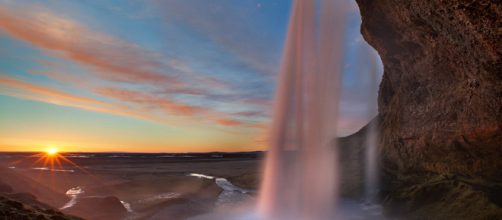Driving in Iceland may not be the smartest thing to do, especially during winter where temperatures can drop to -10°C and blizzards are a daily occurrence outside of the cities.
Based in the capital, Reykjavik, my friend, Rob, and I wanted to explore the natural beauty the country had to offer in the city and away from the lights and people.
Rob has always been a passenger, so it was my responsibility to drive, and during a four-hour trip back to the capital, we were on the verge of being stranded in the freezing cold wilderness, not once, but twice.
But we started in Reykjavik and despite having a smaller population than Solihull in the West Midlands, it is a vibrant and wonderful capital city with picturesque views everywhere you look.
Around the corner of the street from our accommodation, we could stare at the sheer beauty of a mountain in the distance, across from a part of the sea. Our fascination with it was that it looked different every day, depending on the weather and clouds. Sometimes the top was covered in a blanket of clouds, others you could see the peak, and then when it was clear skies, the sun reflected off the white of the snow.
Walking through the main strip, there were your typical bars, restaurants and tourist shops, as well as a phallological museum (all about penises and yes, we did visit).
The real highlight of the city was Hallsgrimskirkja Church. The tallest of its kind in Iceland, reaching a height of 74.5 metres, it became our compass around Reykjavik. If we ever got lost, we looked up for it, standing over every other building, and used it as a reference to navigate our way back to civilisation.
The ground level was average, with the usual altar, pews and font, with the exception that the organ was set on a balcony opposite the altar. With such a tall and oddly shaped religious place, a novelty for British tourists, it needed a lift to the top to look over the city below. What we saw was magic. Imagine sunset, snow-covered rooftops, still able to see the various colours on the buildings and the mountain in the background that overlooked the ocean.
Just breath-taking.
That brought an end to our first week in Iceland, but what was in store for us in the next seven days was what Iceland was really about.
Now for the driving in blizzards...
Driving around mainland Europe for three months gave me some experience of foreign roads, but this would be my first time with the steering wheel on the left, and not to mention in conditions that British people would consider apocalyptic.
Our first day in the wilderness arguably produced the most stunning view that we have ever seen. To acclimatise to the driving conditions, we drove to the nearby national park, Reykjanesfólkvangur, just half hour outside the city.
Icy roads was an understatement, but the sun was out and the clouds were nowhere to be seen.
On our drive around the outskirts of the park, we stumbled across Seltún Geothermal Area. The volcanic tunnels running underneath the surface meant there were hot springs all over Iceland.
Typically used for energy to heat water and environmentally friendly, it also had an unpleasant rotten egg smell that was hard to get used to, due to the sulphur. Beyond the hot springs were snow-covered hills. We had spotted people descending one such hill, bigger than your average one and more comparable to a small mountain, and decided to climb it ourselves.
Climbing on rocks, over small streams and up the steep hillside, it was challenging, especially for Rob, who has a fear of heights, so I powered to the top.
What I saw left me speechless, rooted to the ground in sheer amazement at what my eyes were taking in. I made Rob join me, telling him he needed to witness it for himself.
The surface was barren and void of any trees or plant life, almost comparable to the Moon. Yet, in the distance, the Atlantic Ocean and the orange sky were touching. The sun, setting fast enough for the eyes to see, glistened off the sea and reflecting its rays on the cold blue water.
On our walk down, we tried to describe it, both of us struggling to find the words that would do it justice. After reaching the bottom, we ventured off in another direction towards the smaller hills, where our feet were lost in the snow.
Hours passed and the sun had almost gone from sight before we headed back to Reykjavik.
It may have been our favourite place from our holiday, but Iceland has a variety of wonders to offer.
Waterfalls differed from the gigantic Seljalandsfoss that hit the ground with sheer force to the nearby Gljúfrabúi, hidden and its only entrance in a cave and over stepping stones in the river. Even the vast emptiness on the Langjökull glaciers was breath-taking, albeit freezing at -16°C.
Our trip to Skogafoss produced incredible landscapes just as nature intended. Yet, four-hour journeys back to Reykjavik is not the best option to take in the dark and when blizzards are frequent.
Unable to see barely two feet, with full beam headlights hindering as it reflected off the falling snow, driving was near-impossible in a car not suitable for extreme weather conditions.
It was a miracle that we returned to the capital in one piece. Twice we almost veered off the road, as snow and ice built around the tyres, once coming to a halt just before heading down a slope that would have left us stranded. Definitely driving in the summer next time.
There will be people who write Iceland off because it is not the sunbathing-by-a-pool holiday they are used to. But even adventure holidays produce spectacular moments and Iceland is a place that everyone should visit at least once in their lifetime.

